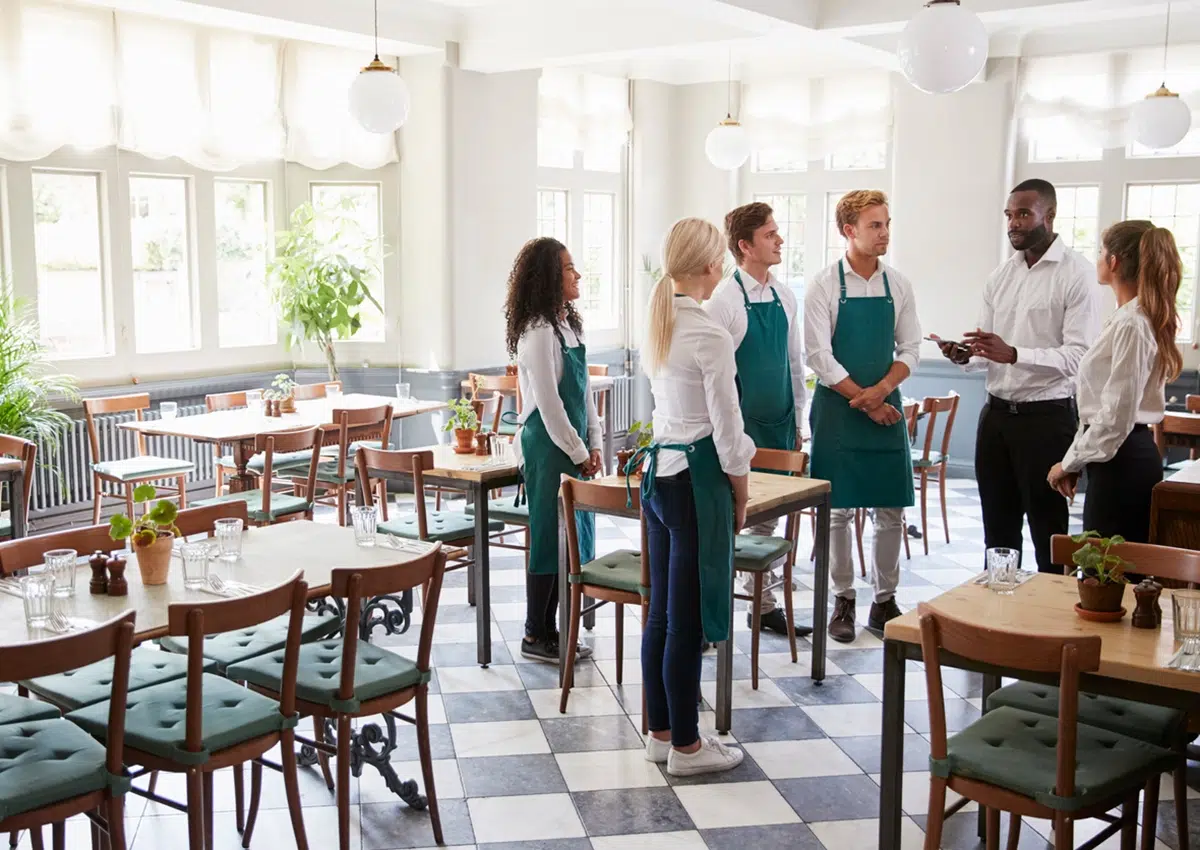Picture this. You’ve finally settled on a tableside ordering system to streamline your restaurant systems. After showing your staff the new tablets and giving them a quick run-through, you open for business as usual and wait for the magic to happen.
With a turnover rate of 60 percent each year, you’re excited for your staff to have easier, more productive shifts.
But, instead of the blissful sound of a well-run dining room and kitchen, you hear something else. The staff is frustrated, the customers are annoyed, and don’t get us started on the back of the house!
Your spot isn’t running like a well-oiled machine; it’s chaos.
Sometime after closing for the night, pouring over customer complaints on Yelp, you realize something crucial: you forgot to train your staff. While you spent hours learning the ins and outs of your iPad-based POS, you didn’t give your crew enough time to master the new system.
Even with technology meant to make their lives easier, people have a learning curve. Learning is personal, and not everyone catches on quickly.
Today, we share some best practices and tips for training your staff to use an iPad POS ordering system like CAKE’s tableside solution.
- Preparing for staff training
- Effective training strategies
- Training staff on advanced POS features and troubleshooting
- Reinforce training with practical experience
- Continuous learning and adaptation
- Measuring training effectiveness
- Tips for ongoing iPad POS training
Understanding iPad POS ordering systems
Traditional POS systems and cash registers rely on a central station where your waitstaff enters orders for the kitchen or bar. Most of the time, your staff can only serve one table at a time and must either memorize or jot down orders tableside. During peak times, your POS becomes a choke point and slows down service.
Using iPad POS ordering technology, your team is essentially carrying around that POS terminal with them everywhere they go! Not only can they transmit orders directly to the bar or kitchen, but they can also take payments at the table. Your staff can relax and focus on providing your patrons with four-star service.
Your customers appreciate a more streamlined dining experience as well. Traditionally, the hands-on time for a full-service restaurant is around 20 to 30 minutes. Of that time, 25% is spent taking an order and 19% taking payment. Implementing an iPad POS ordering system could shave between five and seven minutes, according to some estimates.
Tableside ordering systems also improve order accuracy, benefiting your customers and bottom line.
Basic features
Every iPad POS ordering system revolves around the idea of your servers carrying your POS around with them. This streamlines ordering and allows them to carry out every function of the ordering and payment process tableside. More than that, iPads can display a richly detailed, instantly updated menu with built-in ingredient modifications.
For the back-of-house, iPad POS ordering systems allow you to manage your inventory and workflows effortlessly. You can instantly track what you have in stock and update the menu to reflect that on the fly.
Overall, implementing iPad POS ordering in your restaurant can transform how your table management operates. You’ll see faster table turns, fewer errors, and a happier staff able to focus on providing your customers with the best!
Click here to see CAKE’s complete set of features for integrating your entire workflow.
Preparing for staff training
Training your staff isn’t just about making them comfortable with your new system. It’s a vital part of keeping your business thriving. Before you begin working with your staff, it’s a good idea to get a sense of how comfortable they are with technology.
Assess your staff’s comfort with technology
Sometimes, a simple survey might be enough to understand how your staff feels about working with new technology. Some might need to start from the basics, so keep that in mind when designing your training modules.
Set clear objectives
Next, set some clear training objectives for your sessions. Decide how quickly you want your staff to feel comfortable with the new ordering system and plan accordingly. Servers who are comfortable with the technology might only need 30 minutes to feel confident with their iPads. This won’t be the case for everyone, so take the time to ensure your staff is ready before rolling it out.
Create a supportive environment
Your training environment should be fun and supportive. Staff should know that mistakes during training are expected. If you plan to bring in an outside trainer, get them on board with your philosophy so they’re ready to help your staff shine!
Effective training strategies
Through our experience in the restaurant industry, we’ve identified some effective training strategies for implementing iPad POS ordering systems. You can mix and match these methods for a comprehensive training session.
- Step-by-step training takes your staff through the process of taking orders and payments one step at a time. Before moving on to the next function of the software, you’ll make sure that your staff understands the system.
- Interactive learning sessions allow your staff time to work with the system and ask questions as needed.
- Role-playing scenarios let your staff challenge themselves by taking mock orders from their colleagues. If you’ve got some reluctant adopters, this is an excellent chance to show them how effective the new system is in “real-life” scenarios.
- Incorporate visual aids and demonstrations into your training sessions to highlight key features and crash-test the system.
When your training sessions are complete, make sure your staff knows that they are still welcome to ask questions. And, as you inevitably onboard new staff members, identify some POS rockstars to mentor them.
Training staff on advanced POS features and troubleshooting
Beyond just learning how to take and enter orders and process payments, your staff can benefit from learning about some advanced features. Identify some superstars in your team that can serve as training mentors for some of these more complex functions.
Basic troubleshooting skills
During regular service, your iPad POS ordering system should work seamlessly. But when it doesn’t, you’ll want your staff to be able to handle challenges without your help. Common issues like card read errors and network failure can throw a streamlined system into chaos. Give your staff the tools to resolve these issues during training.
Know when to seek technical support
While you want your staff to feel empowered to fix issues that pop up, it’s also necessary for them to know when to seek support. We’ve focused on the user experience in developing CAKE, so when problems arise, we’re here. Anytime they feel frustrated, they should reach out for help!
CAKE provides 24/7 customer service via text, email, or chatbot for your convenience.
Reinforcing training with practical experience
As your staff feels comfortable with your iPad POS ordering system, here are a few ways to reinforce training.
Hands-on practice sessions
Giving your staff a chance to practice using your POS in low-risk scenarios can help them feel like experts. Training new staff can be expedited by allowing them to use the software as soon as possible.
Shadowing experienced staff
Assign your new employees an experienced mentor to shadow during service. They’ll start to pick up on best practices for interacting with patrons and the technology.
Real-time feedback and support
When you run into problems, addressing them as soon as possible is important. Allow your staff to make corrections and let them know when they’re doing things better. It’s crucial that you don’t embarrass your staff in the moment. Instead, set some procedures in place for giving real-time feedback.
Continuous learning and adaptation
With legacy POS systems, maintenance is one of the most expensive aspects. Updating your integrated iPads and cloud-based POS can be simple. At Mad Mobile, we’re dedicated to constantly innovating to optimize CAKE for your convenience.
Whenever there’s an update, give your staff a refresher course on new features and functionality. And feel free to let us know about your staff’s feedback and suggestions. Maybe their problem will inspire the next solution.
Measuring training effectiveness
Bringing a new system online can feel like reinventing the wheel. But once it’s up and running, you can take some time to go back and evaluate your training.
Performance metrics to track
Ideally, your new iPad POS system’s real-time reporting of that information can help you determine if your training sessions were effective. In CAKE, you can track and analyze data from throughout your operation. This could include upsells, modifiers, and reviews.
Gather staff feedback
Customers vote with their business, but you should regularly check in with your staff. They should feel that their opinions are valued and their concerns taken seriously. Survey them about what worked and what needs improvement with your training process.
Adjust training as needed
Make adjustments if you see growth areas in your training system, either because of metrics or employee feedback. Your employees will appreciate that you take and implement their advice.
Tips for ongoing iPad POS training
Once your staff has their initial training, it’s important that they continue developing their proficiency. Encourage regular practice to increase their fluency with the system, especially if you have a complex menu.
Incentivize mastery of the system
Consider the metrics you’ve decided demonstrate mastery of your system, and give prizes! Hold a competition among your staff for things like upselling and publicly recognize the winners. They’ll appreciate the recognition, and your staff will work faster to master their tablets.
Create a knowledge-sharing culture
Encourage your staff to share discoveries about the system with each other. You’ll be amazed at how quickly your servers can solve problems together. Beyond that, knowledge-sharing can also increase retention and employee buy-in, reducing how frequently you need to train new staff.
Wrap up
Designing and implementing effective training solutions for iPad POS ordering systems can help you avoid a nightmare scenario. Investing in a new system is great until you forget to train your staff appropriately. With adequate training, your staff will feel empowered and more knowledgeable. Luckily with CAKE’s ordering tablets, training time can be shaved down to a minimum as it features the same interface as our easy-to-use restaurant POS system.
Have you had experience onboarding your staff to a new POS? Let us know the good, bad, and ugly in the comments.
For cutting-edge POS design and best-in-class support, CAKE is your one-stop solution.







